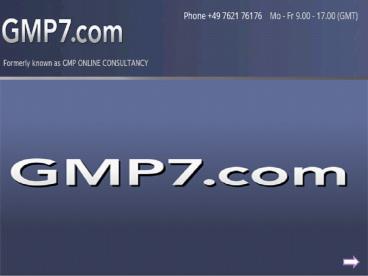Good Manufacturing Practice - PowerPoint PPT Presentation
Title:
Good Manufacturing Practice
Description:
For good manufacturing practice just visit Gmp7.com and assure the best quality for the products which guarantees the product is produced consistently and its quality maintained. – PowerPoint PPT presentation
Number of Views:473
Title: Good Manufacturing Practice
1
(No Transcript)
2
GMP Good Manufacturing Practice
- What is GMP - Good Manufacturing Practice ?
- We all know that microorganisms bacteria,
viruses, protozoan's, fungi, etc. are present
everywhere in the atmosphere. What if the tablets
you are manufacturing or devices you are
packaging get contaminated by a few harmful
bacterial cells? Even slight error in the
concentration of a chemical substance can show a
different reaction. What if a few milliliters of
a hazardous chemical is poured into that cough
syrup? You risk the life of thousands of innocent
patients who consume your medicine thinking that
it will cure their diseases. Such an erroneous
act may compel the government authorities to shut
down your manufacturing unit. To ensure that a
scenario like this never occurs, the FDA has
enforced a regulation Good Manufacturing
Practice (GMP). The GMP guidelines and principles
are legal codification of quality and purity that
must be followed right from intake of raw
materials to manufacturing, testing and packaging
of active pharmaceutical ingredients, medical
devices and other products so that the end user
gets product in its safest and purest form.
Over hundred countries have provided their own
legislation for pharmaceutical, food and biotech
companies to comply with GMP guidelines and
principles. The basic concept and guidelines of
them all remain the same.
3
GMP Regulations in Good Manufacturing Practice
- Almost all the regulations are centered around
cleanliness, sanitation, efficiency of
equipments, complaint handling, record-keeping
and personnel qualifications. Since these
guidelines are pretty flexible, its helpful for
business owners and managers to understand the
requirements in their own way and implement them
effectively. - 1- EquipmentsThe equipments and utensils used
should be made of appropriate materials and
design to prevent corrosion, dirt or any external
chemical agent from altering the composition of
ingredients used to manufacture a product.2-
PersonnelThe employees performing various tasks
must have appropriate educational qualification
and training. They should wear proper protective
gear like hand gloves and apron to prevent
contamination and hazards. Forbid them to consume
food, drink, tobacco, cigarette smoking within
the manufacturing premises. 3- Building and
FacilitiesBuilding that houses the
manufacturing unit should be of suitable design
and size to accommodate all the equipments.
Floors and ceilings should regularly be cleaned.
Proper sanitation, ventilation and lighting are
very important for sanitary as well as staff.
4
- 4- Raw MaterialsThe three most important
things to be considered about raw materials are
quality, storage and treatment. Make sure that
the raw materials you purchase are of standard
quality. Store and treat them properly to avoid
contamination, heat, cold and moisture. Label
them and take a small sample to test it for
purity.5- Manufacturing ProcessEnsure that
the process you use is proven to produce a
pharmaceutical product of high quality. It should
be fully controlled and clearly defined. Any
change in the process must be evaluated. Each
employee should be handed a process manual
written in clear and unambiguous language. 6-
RecordsKeep the records and results of sample
tests for every batch so that the complete
history of the batch, right from the raw
materials to distribution, can be traced whenever
required. 7- LabelingLabel is the statement
of identity for any product. It should clearly
mention the name of product, ingredients, batch
number, manufacturing and expiry dates, direction
for use and warnings. 8- InspectionThe
Pharmaceutical Inspection Cooperation Scheme
(PICS) and Pharmaceutical Inspection Convention
work together to inspect whether or not the
pharmaceutical companies comply with the GMP
requirements. If your compliance is poor and many
deficiencies are noted, your manufacturing unit
has to be re-audited.
5
Contact Us !
Im Schwarzenbach 6 Weil am Rhein Baden-Wurttemberg
-79576 Germany Phone 49(0)7621-76176
Email info_at_gmp7.com
Website http//www.gmp7.com/
Back to Home































![Read [PDF] Good Manufacturing Practices for Pharmaceuticals, Seventh E PowerPoint PPT Presentation](https://s3.amazonaws.com/images.powershow.com/10086933.th0.jpg?_=20240727096)